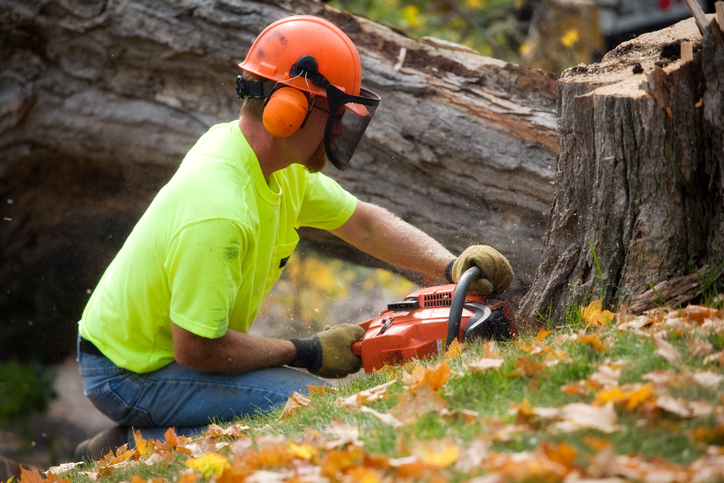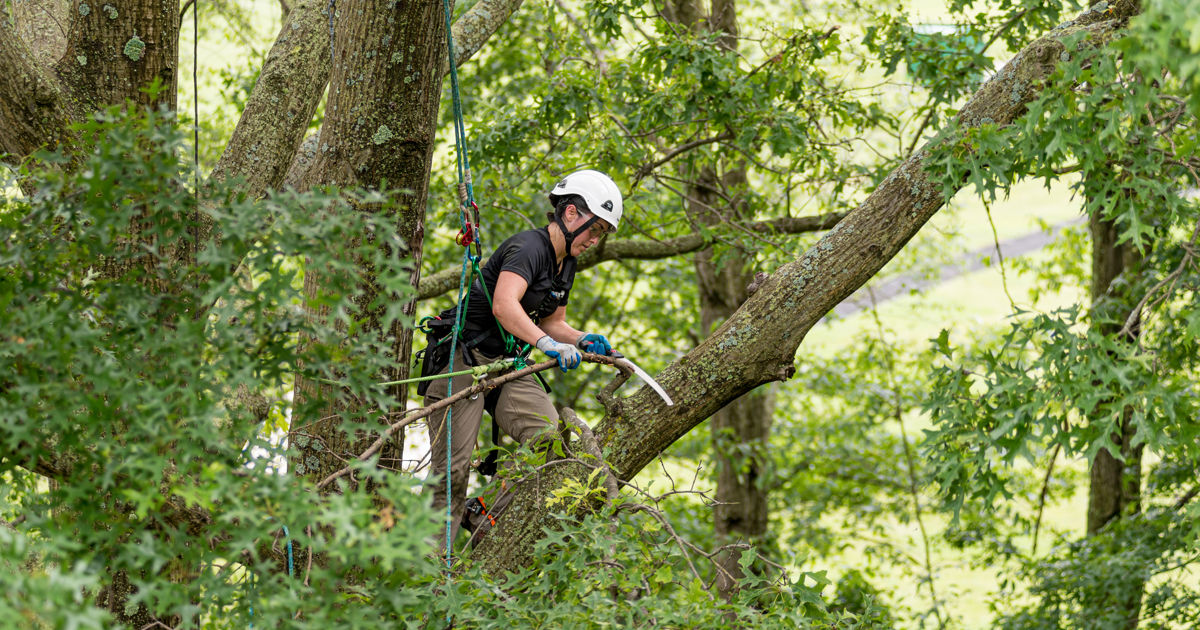Safe and Effective Tree Removal for a Healthier Landscape
The process of reliable and safe tree removal is important in cultivating a much healthier landscape, specifically when resolving the dangers associated with diseased or unsteady trees. Homeowners face a crucial choice in between utilizing expert solutions or deciding for a do-it-yourself approach, each carrying its very own ramifications for safety and security and performance. Understanding the nuances of this process, consisting of essential safety measures and post-removal care, can substantially influence the long-lasting health of your outdoor environment. The inquiry remains: what variables should be taken into consideration to make sure both safety and ecological stability during this undertaking?
Importance of Tree Removal
Tree removal plays a vital duty in maintaining a healthy landscape, with research studies indicating that roughly 30% of trees in metropolitan locations may be unhealthy or at threat of collapse. This fact highlights the value of positive tree management, as unhealthy trees position substantial dangers to both building and public safety. Diseased trees can bring in parasites and illness that threaten other plant life, interfering with the eco-friendly balance within the landscape.
Moreover, tree elimination can boost the visual charm of a location. Getting rid of thick or inadequately positioned trees permits for far better light infiltration and improves the growing conditions for bordering plants. This method sustains the total health and wellness of the landscape, fostering a much more dynamic and varied community.
Furthermore, tree removal is necessary in metropolitan growth and infrastructure preparation. As cities broaden, the demand to clear room for building and construction or highways often demands the removal of trees that impede progress. When performed properly, tree removal can help with sustainable growth while prioritizing safety and environmental health and wellness.

Assessing Trees for Removal
Reviewing the condition of trees is a vital action in the removal procedure, making certain that decisions are based upon comprehensive assessments as opposed to presumptions. To begin this examination, a visual assessment ought to be conducted, concentrating on indications of illness, pest problems, and architectural weak points. Key indications consist of dead branches, bark abnormalities, and substantial lean.
Next, it is important to assess the tree's total health and wellness and vitality. This entails analyzing leaf growth, density, and pigmentation patterns. Trees showing stunted development or discolored foliage might indicate underlying issues that require removal. Additionally, think about the tree's place about structures, various other plants, and public safety and security. Trees that present risks as a result of their distance to structures or power lines need to be prioritized for analysis.
Additionally, expert arborists can make use of advanced analysis devices, such as resistographs or sonic tomographs, to evaluate the interior honesty of the tree. These devices aid recognize degeneration or architectural deficiencies that may not be noticeable on the surface. Ultimately, a detailed assessment will assist informed choices concerning tree removal, making certain that the landscape stays healthy and balanced and safe for all.
Safety Preventative Measures and Tools
Safety is vital when undertaking tree removal, as the process entails intrinsic risks to both employees and home. Before beginning any kind of tree removal procedure, it is vital to carry out a detailed danger evaluation to determine prospective risks such as nearby frameworks, high-voltage line, and unpredictable ground problems.

Proper personal protective devices (PPE) is crucial; this consists of tough hats, security goggles, handwear covers, and steel-toed boots. In addition, hearing security needs to be worn when operating loud machinery.
The right tools are crucial for safe and efficient tree elimination. Power saws are generally made use of, but they require proper handling and upkeep. Constantly make sure that the power saw is furnished with a functioning chain brake and that the operator is educated in its usage. Various other essential tools include ropes for rigging, wedges for guiding falls, and a trimming saw for smaller branches.
Developing a clear job zone, connecting properly with all employee, and having a first-aid kit easily offered adds to a safer removal procedure. By sticking to these safety precautions and employing ideal tools, tree elimination can be implemented effectively while minimizing threats.
Professional vs. Do It Yourself Removal
Frequently, home look at this site owners locate themselves considering the pros and cons of expert tree elimination solutions versus trying the job themselves. While DIY removal can be appealing due to cost financial savings, it positions considerable threats and challenges. Tree elimination requires specialized expertise regarding tree biology, architectural stability, and safe cutting strategies, which the average home owner might do not have. Improper techniques can bring about injury, residential property damage, or perhaps damage to bordering trees.
On the other hand, hiring a specialist tree removal service ensures that the job is executed securely and efficiently. Toronto tree removal. Professionals are equipped with the right tools and have the necessary experience to assess the scenario properly, decreasing threats. They can likewise deal with disposal and clean-up, which can be a cumbersome task for people attempting DIY removal
Moreover, professional services usually provide insurance policy, protecting property owners from possible liabilities in situation of crashes. While the preliminary price might be greater, the long-term benefits of professional services-- such as security, efficiency, and peace of mind-- can outweigh the temporary financial savings of a DIY technique. Inevitably, the choice should think about factors like the dimension and location of the tree, the property owner's experience, and the possible hazards included.
Post-Removal Landscape Treatment
As soon as a tree has been successfully gotten rid of, focus should turn to the landscape's care to ensure it continues to be aesthetically attractive and healthy and balanced. When stood, the first step involves attending to the location where the tree. This consists of eroding the stump otherwise currently completed, as this prevents possible insect problems and enables new growth.
Ultimately, it is vital to fill deep space left by the tree. Use high quality topsoil to level the ground, promoting correct drain and avoiding erosion. Depending on the landscape style, consider growing new trees or bushes in the area to preserve equilibrium and looks.
Watering and feeding the surrounding soil will certainly urge valuable microbial activity, making certain an abundant environment for new growings. Monitor the why not look here area for any kind of indicators of illness or pest activity, as the elimination of a tree can interfere with regional ecosystems.
Finally, take into consideration mulching the location to reduce weeds and maintain wetness. Normal upkeep, including weeding and regular examinations, will certainly aid copyright the landscape's health and elegance. By investing time in post-removal care, you can make certain a thriving, sustainable setting that enhances your general landscape.
Conclusion
To conclude, secure and reliable tree elimination plays an important role in preserving a much healthier landscape. The careful analysis of trees, adherence to security precautions, and the option in between expert services or do it yourself methods are crucial factors to consider. Furthermore, post-removal treatment, consisting of stump replanting and grinding, adds to environmental equilibrium and visual enhancement. Ultimately, reliable tree removal not only reduces dangers however additionally cultivates a flourishing setting that profits both human and wildlife populaces.
The procedure of reliable and risk-free tree removal is vital in fostering a much healthier landscape, particularly when resolving the dangers linked with diseased or unstable trees.Tree elimination plays a vital duty in preserving a healthy landscape, with studies showing that about 30% of trees in urban areas may be unhealthy or at danger of collapse. Eventually, a Full Report comprehensive assessment will certainly direct informed choices relating to tree elimination, ensuring that the landscape stays healthy and balanced and safe for all.
